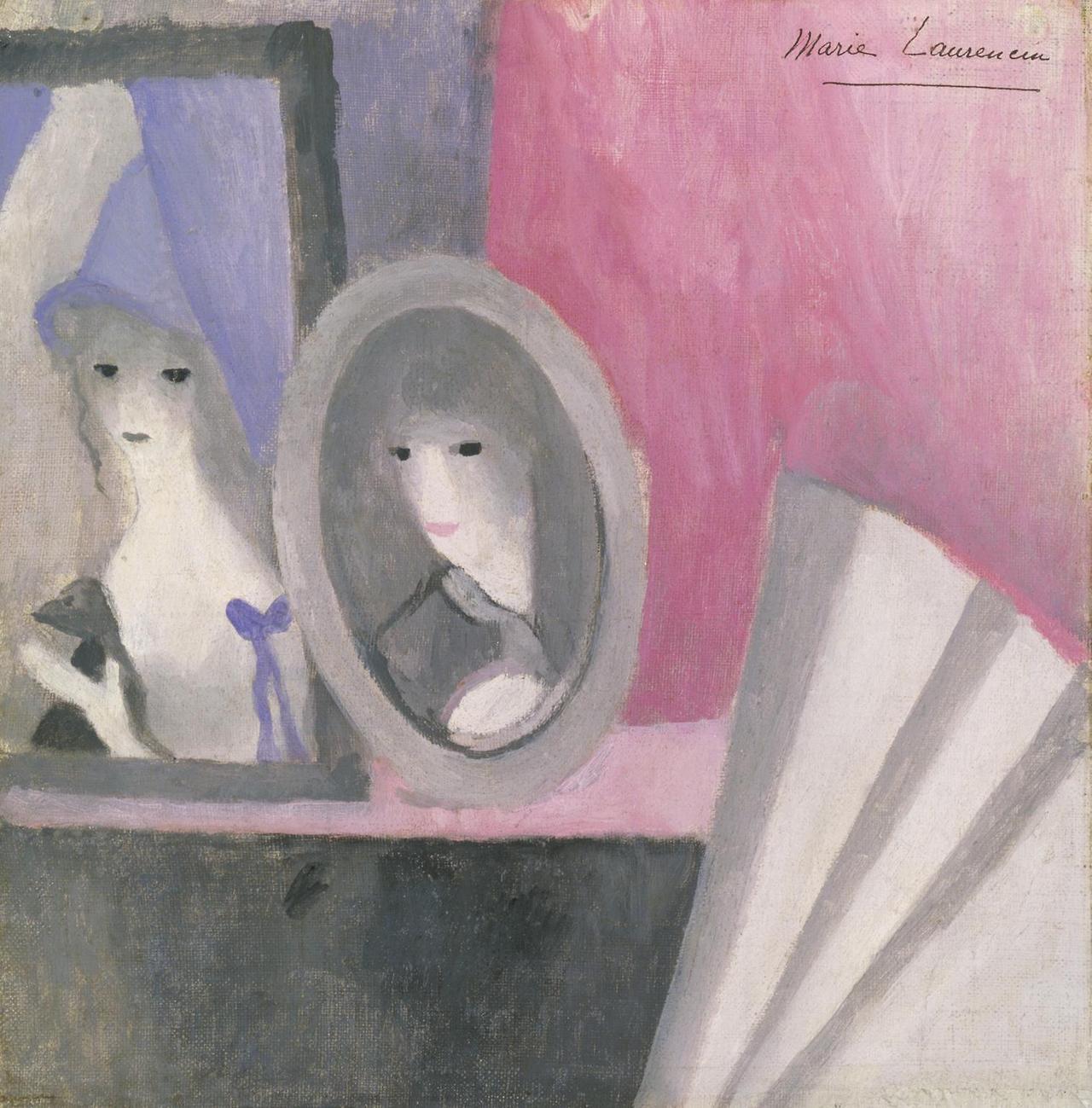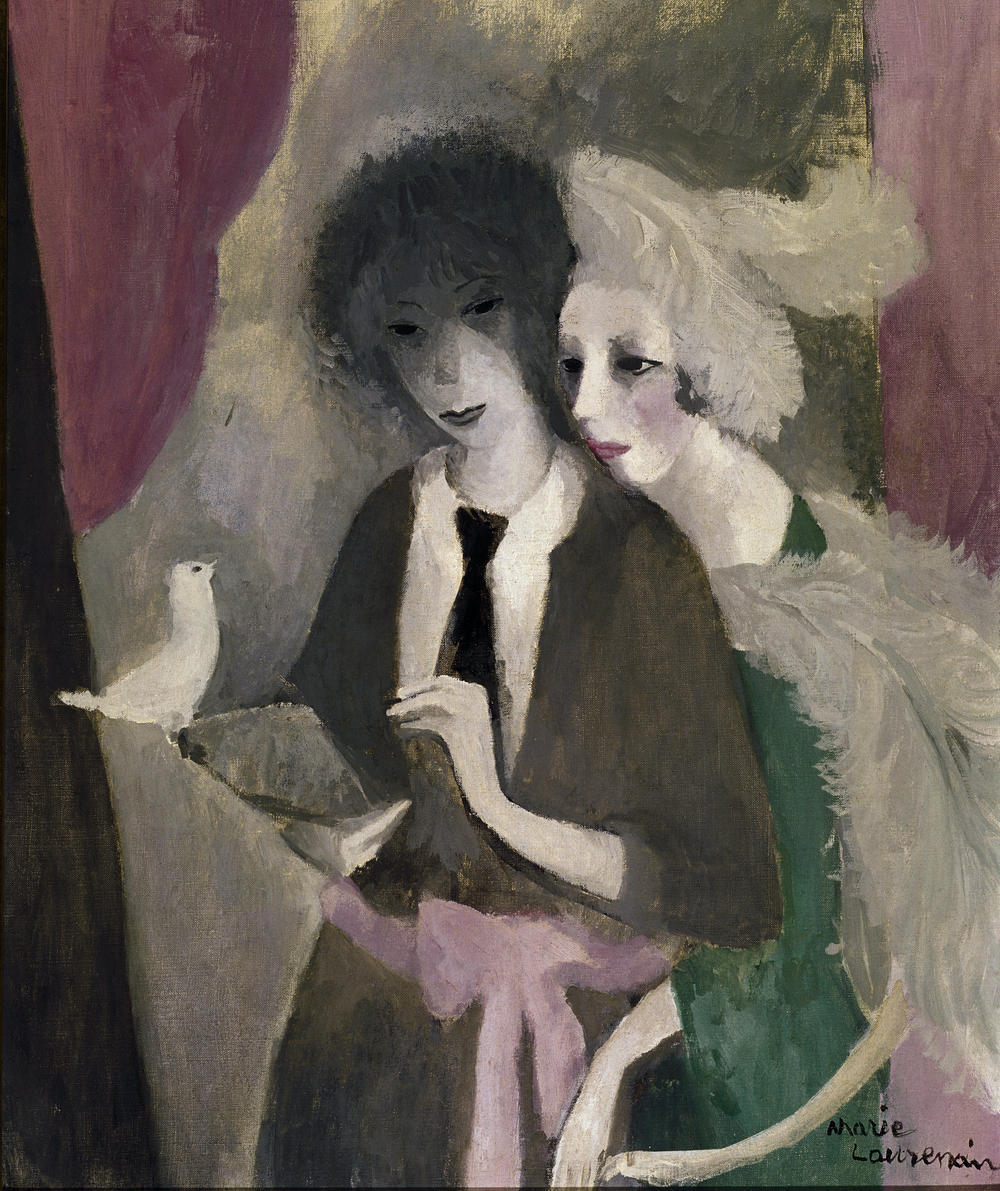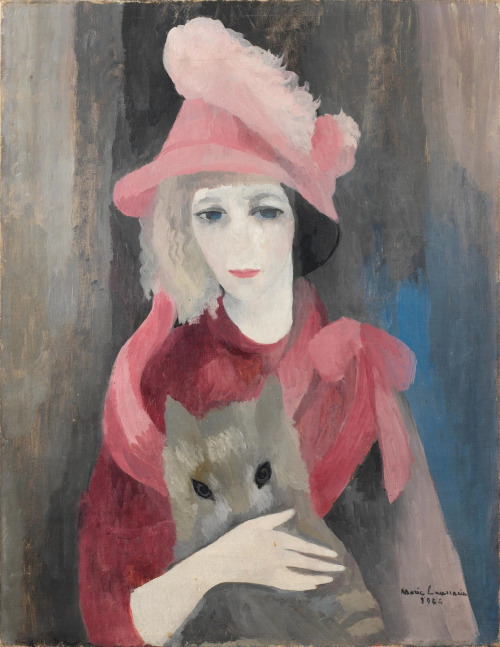“Why should I paint dead fish, onions and beer glasses? Girls are so much prettier.“
(Marie Laurencin)
 Marie Laurencin, Woman with dog and cat (Femme au chien et au chat), 1916
Marie Laurencin, Woman with dog and cat (Femme au chien et au chat), 1916
As it is usually the case with female artists, Marie Laurencin (1883-1956) was partly forgotten and partly misremembered. She is mostly remembered as a part of the French avant-garde, muse to Guillaume Apollinaire who poetically bestowed the name “Our Lady of Cubism” upon her. A female Cubist, a muse, just another figure in the modernist Parisian art circles. But all of these titles, as flattering as they sound, do not do the justice to the lyrical, gentle beauty of Laurencin’s paintings. Born on the last day of October in Paris in 1883, Laurencin moved to Sèvres at the age of eighteen to study porcelain painting. After that, she returned to Paris and pursued studying oil painting at the Académie Humbert. Her work stretched from the early twentieth century up until her death. She was especially successful in the 1920s, but in 1930s, due to the economic crash, besides painting she also worked as an art instructor in a private school. While it is easy to noticed the changes and developments of her style and themes, her paintings always have that certain beautiful quality that makes them so wonderful and unique, and it makes you think that no one else could have painted them but Marie Laurencin herself.
These days I am particularly captivated by the beautiful harmony of pinks and greys in Laurencin’s paintings. So many enchanting shades of grey! Grey like the sky on an autumn day, grey like the fluffy lead-coloured springs clouds full of rain, grey like a soft bunny’s fur, grey like the waters of Seine that Apollinaire mentions in one of his poem called “Marie” written for Laurencin, grey as something gentle, fading and romantical.
“I was walking along the Seine
An old book under my arm
The river is like my sorrow
It flows and does not end
So when will the week be done.“
(last stanza from “Marie” by Apollinaire, translation found here.)

Marie Laurencin, The Fan, 1919
“The masks are silent
And the music so distant
That it seems descended from heaven
Yes, I want to love you, but love you barely
And my disease is delicious.”
(“Marie”, Apollinaire, found here.)
All the feminine gentleness of Laurencin’s work lies in those soft shades of grey. The girls in all these paintings, dreamy Parisian waifs, with elongated, thin, mask-like faces bring to mind the slender, gaudy ladies from Kees van Dongen’s canvases. Their skin is grey, their eyes large, silent, poetic and deep, their gazes wistful and inviting. Strange doll-like stillness, paleness, quietness lingers through these canvases. And when the soft grey shades meet the more vibrant, almost garish shades of pink, purple, blue, turquoise, then the true magic occurs. Softness, gentleness, sweetness prevail in these portraits, these girls in pinks and greys are girls seen through the feminine lens of a female painter. To call Laurencin “a female Cubist” is almost an insult to these charming, delicate paintings which posses none of the mathematical, objective, steel-coldness of the Cubist artworks. Laurencin’s portraits are like pages from a young girl’s diary, lyrical and coated in sweetness, but not shallow or sentimental because they have that something, a touch of mystery, secrecy and silent which makes one wonder. She even said herself: “Cubism has poisoned three years of my life, preventing me from doing any work. I never understood it. I get from Cubism the same feeling that a book on philosophy and mathematics gives me. Aesthetic problems always make me shiver. As long as I was influenced by the great men surrounding me I could do nothing.”
Laurencin was a part of the Cubist circles but her work is certianly not. Her exploration of colours is, to me, more reminiscent of Fauvism. Look at that turquoise and bright pink the painting “Woman with Dog and Cat”! I don’t understand why the feminine element is often overlooked in her art. She is not less of an artist if she painted pretty girls in pastel colours. She is mostly remembered as just a Cubist muse, but at the same time Picasso’s Cubist guitars and violins, broken to pieces canvases, that is seen as avant-garde and revolutionary, and I don’t see why. Laurencin said something interesting about women and painting: “I conceive of a woman’s role to be of a different nature: painting to be essentially a “job” for a woman (one who sits so long quiet on a chair); and a painter’s inspiration to be life and that of natural sensibility rather than the outcome of intellect or reason. There is something incongruous to me in the vision of a strong man sitting all day… manipulating small paint brushes, something essentially effeminate.”

Marie Laurencin, Femme à la colombe (Marie Laurencin et Nicole Groult), 1919

Marie Laurencin, Woman with Dog (La femme au chien), c. 1924

Marie Laurencin, The Kiss, 1927


